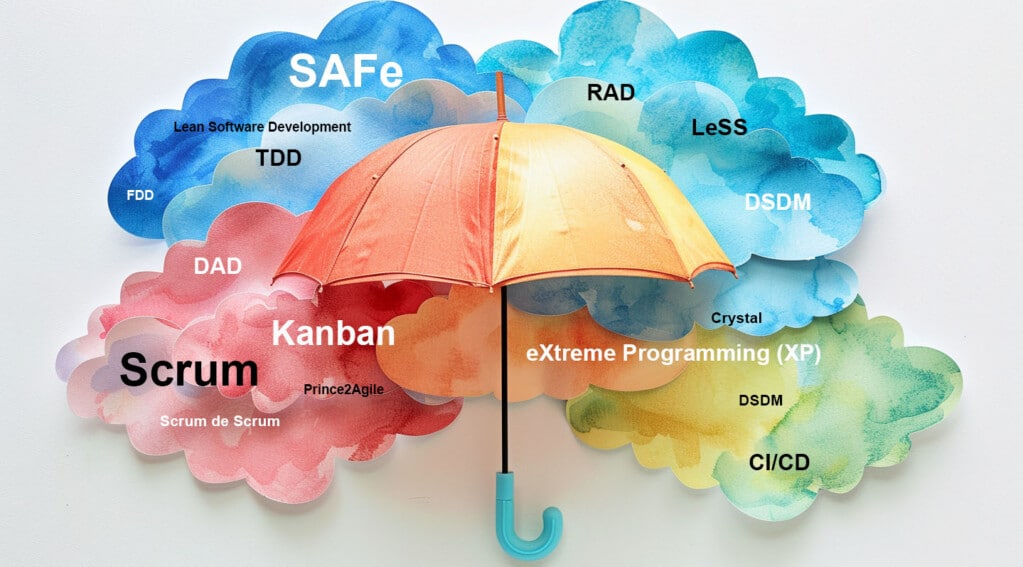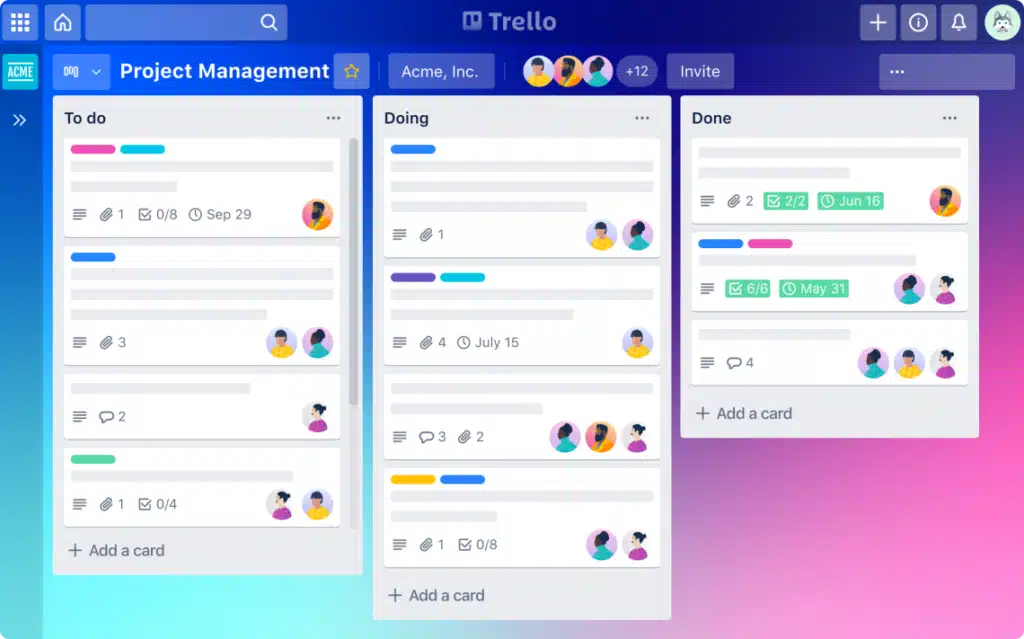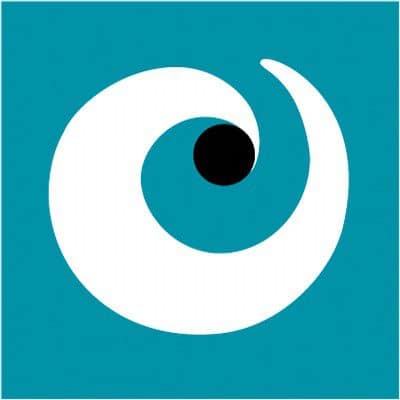Agile methods have revolutionised project management: flexible, collaborative team management, permanent product alignment with customer expectations, continuous testing... All very well, but which solution should you choose? Discover the most popular agile repositories and learn how to identify the one best suited to your needs.

Prioritize customer satisfaction, collaborate, adapt. Here are some of the principles of agile methods as they were imagined in the 1990s and popularized by the manifesto written in 2001 in the United States by 17 software development specialists.
There is a before and after of agile methods. They have revolutionized the overall approach to project management, what experts call “ life cycle » of a project.
Le IT sector was the pioneer, seeking more flexible and responsive working methods in the face of frequent product updates and customer expectations.
Agile methods have made it possible to accelerate development cycles, foster closer collaboration between teams and better respond to evolving market needs. They were subsequently adopted by other sectors, demonstrating their effectiveness and adaptability in various professional contexts.
However, 30 years after their appearance, agile methods have become a thicket that is difficult for non-specialists to decipher. On the one hand, the multitude of approaches available can be confusing. On the other hand, their technical jargon may seem impenetrable to newbies.

Choosing the right agile method, a challenge for the project manager
Where to start ? Which approach to choose? Faced with the diversity of methods, it is crucial to understand each solution in order to choose the one that best meets your needs.
Choosing an approach first involves considering the specifics of your project : type of product or service developed, size of the team, organization of the company, complexity of the project, budget allocated, deadlines, etc.
And, surprise, depending on the nature of your project, agile methods will not necessarily be the most appropriate.
Before agile: traditional project management methods
So-called traditional methods (cascade, integration, V-cycle, etc.) use a sequential approach, the project being divided into phases and stages which follow one another.
Waterfall model or waterfall
Coming from industry and construction, it is the oldest model (1966-70). The waterfall model consists of dividing a project into linear and sequential phases. A completed and validated step allows you to move on to the next one, without returning to the previous phase.
The phases follow one after the other, hence its name waterfall model.
This model usually includes the following phases:
- Definition of needs (or requirements)
- Analysis (specifications)
- Design
- Implementation (development for a digital project)
- Testing
- Deployment or operation
- Maintenance
Implementation of this method requires a lot of preparation and planning with the drafting of detailed specifications. It gives very good visibility on the objectives and the progress of the project if the project has been well defined upstream. Once the project is launched, it is difficult to make adjustments or flashbacks. However, if a phase is not validated, you can return to the previous phase.
Recommended for : small projects, not very complex, short projects…
Not recommended for :
- Long projects (more than a year)
- Complex projects, with many stakeholders
- Projects with an environment that changes too quickly or evolves
- Projects that reveal functional needs under development
- Problems not discovered before testing
V-cycle
This is the classic model par excellence in project management. Derived from the waterfall model, it has been used since the 1980s, particularly in software development, to carry out a project while respecting the requirements of quality, cost and deadlines.
It is characterized by two phases, a top-down design and development phase, followed by a bottom-up testing and validation phase.
Recommended for :
- Projects with clearly defined and stable requirements
- Projects requiring detailed documentation at each phase
- Projects with long, planned production cycles
Not recommended for :
- Projects requiring rapid delivery (validation phases may delay availability)
- Short projects
- Projects with evolving and uncertain needs
- Projects requiring a close relationship with the user
The most popular agile methods
As we have seen, traditional project management methods lack the flexibility to react to changes. They also cause the famous tunnel effect which occurs when a team or individual loses sight of the end goal of a project because they focus too much on immediate tasks.
Some examples :
- A software development team so focused on writing code that they don't notice that the customer's requirements have changed.
- A project manager so focused on meeting the schedule that he doesn't notice that the team is burning out.
- A marketing team so focused on its advertising campaign that it doesn't notice that the competition has launched a new product.
Its consequences can be deleterious: budget overruns, delays, poor quality or unsuitability for the market of the final product, demotivation of the team, customer dissatisfaction, etc.
Fortunately, agile methods come to the rescue.
Scrum: the best agile approach for digital projects
Developed in 1995 in the United States, Scrum has become the most popular agile project management approach, especially in software development. More than a simple method, Scrum is a framework that advocates an iterative and adaptive approach.
Scrum is based on well-defined roles: the Scrum Master who leads the team, Product Owner which represents customer needs, as well as short sprints (1 to 4 weeks), regular meetings and close collaboration between the different stakeholders.
This approach promotes flexibility, transparency and continuous improvement, allowing you to quickly adapt to changes and user feedback.
Recommended for :
- Software development, web projects, changing environments where requirements evolve frequently…
Not recommended for :
- projects with very short deadlines (a few days or weeks)
- simple or predictable projects
- projects with an environment that changes too quickly or too frequently
- multi-team or multi-product projects
The best tools for Scrum
- Project management agile : Jira for monitoring the development of a product: product backlog (product owner) or planning sprints and burndowns (scrum master), Bubble Plan, Sprint.ly, Gitlab or Jixee
- Communication: Teams or Slack to communicate as a team by messaging or video
- Documentation : Confluence to manage collaborative documentation
- Protyping : Adobe XD, Figma, Invision...
- Data analysis : Google Analytics, Amplitude, Matomo, Semrush, Hotjar...
- Collection of user feedback : User Testing, Clicktale, Google Form, SurveyMonkey…
Kanban: the most visual of agile methods
Created in the 1950s, Kanban was imagined by Taiichi Ōno, an engineer at Toyota factories, to help teams plan and optimize production.
Its principle consists of creating different shared tables to list each objective, which can be divided into sub-objectives or different tasks to be accomplished beforehand. She uses virtual post-its, Kaban meaning “label” in Japanese. This visual method emphasizes workflow. The online solution Trello is a good example.
It facilitates tracking and provides at-a-glance visibility of tasks, their priorities, the people involved and the progress of each task.

Recommended for : software development, web projects, changing environments where requirements evolve frequently…
Not recommended for :
- projects with poorly defined roles and responsibilities
- projects with tasks that have strong dependencies between them
- complex or large-scale projects: Kaban is overwhelmed by the high number of tasks, and therefore virtual post-its
- projects requiring a strong hierarchy and centralized control: Kanban encourages autonomy and collaboration between collaborators
The tools :
- Trello or Jira for tables
- Concept and Asana
- Miro as a virtual whiteboard
Extreme Programming (XP): for small teams
Dating from 1996, this rigorous approach is particularly suitable for small teams working in a changing environment. It emphasizes communication, collaboration, automated testing and feedback.
Lean Software Development: for complex agile projects
Inspired by the principles of Lean manufacturing, this method aims to eliminate waste and optimize the value flow. It is particularly useful for teams developing complex software products.
SAFe (Scaled Agile Framework) : to make several teams work
A framework for scaling agile practices to large organizations. It offers a structured approach to coordinating the work of several agile teams, which Scrum or XP does not allow.
In conclusion, agile methods are not suitable for all projects. First, because a project is strongly linked to the structure and culture of a company. Then, because the size of the project or team(s) may require other approaches.





